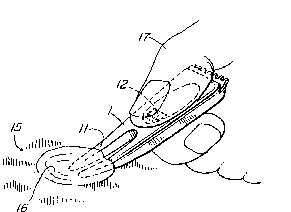Some of the information on this Web page has been provided by external sources. The Government of Canada is not responsible for the accuracy, reliability or currency of the information supplied by external sources. Users wishing to rely upon this information should consult directly with the source of the information. Content provided by external sources is not subject to official languages, privacy and accessibility requirements.
Any discrepancies in the text and image of the Claims and Abstract are due to differing posting times. Text of the Claims and Abstract are posted:
| (12) Patent Application: | (11) CA 2067090 |
|---|---|
| (54) English Title: | GOLF CLUB GROOVE CLEANER AND TURF REPAIR TOOL |
| (54) French Title: | OUTIL POUR REPARER LE GAZON ET NETTOYER LES RAINURES DES BATONS DE GOLF |
| Status: | Deemed Abandoned and Beyond the Period of Reinstatement - Pending Response to Notice of Disregarded Communication |
| (51) International Patent Classification (IPC): |
|
|---|---|
| (72) Inventors : |
|
| (73) Owners : |
|
| (71) Applicants : |
|
| (74) Agent: | |
| (74) Associate agent: | |
| (45) Issued: | |
| (22) Filed Date: | 1992-04-24 |
| (41) Open to Public Inspection: | 1992-10-25 |
| Examination requested: | 1992-04-24 |
| Availability of licence: | N/A |
| Dedicated to the Public: | N/A |
| (25) Language of filing: | English |
| Patent Cooperation Treaty (PCT): | No |
|---|
| (30) Application Priority Data: | ||||||
|---|---|---|---|---|---|---|
|
ABSTRACT OF THE DISCLOSURE
The invention provides a small, inexpensive cleaning device
that is particularly made to clean the grooves in the face of
most golf clubs heads, both irons and drivers. The object of
these grooves is to give the ball direction and backspin. If
these grooves become clogged the player no longer gets the
proper backspin on the golf ball and loses directional
accuracy. The device has at one end a series of small evenly
spaced fixed teeth, each reinforcing ribs to minimize the
risk of the teeth breaking while the device is being used to
clean the golf club head. The device can be twisted with
respect to the golf club head to enable the cleaning of a
variety of evenly spaced parallel grooves. Additionally, the
device has a pair of large sharp prongs on its opposite end,
which can be used to clean golf shoes and to repair divots
and golf ball marks in the turf on golf course greens. The
prongs have a bend that can be used in conjunction with the
edge of a ball mark depression on the golf green as a fulcrum
to leverage the turf back to a level shape. A thumb grip
concavity is equipped with tread lines to prevent the user's
hand from slipping onto the teeth when the prongs of the
device are being used to repair turf.
Note: Claims are shown in the official language in which they were submitted.
Note: Descriptions are shown in the official language in which they were submitted.

2024-08-01:As part of the Next Generation Patents (NGP) transition, the Canadian Patents Database (CPD) now contains a more detailed Event History, which replicates the Event Log of our new back-office solution.
Please note that "Inactive:" events refers to events no longer in use in our new back-office solution.
For a clearer understanding of the status of the application/patent presented on this page, the site Disclaimer , as well as the definitions for Patent , Event History , Maintenance Fee and Payment History should be consulted.
| Description | Date |
|---|---|
| Inactive: IPC expired | 2018-01-01 |
| Inactive: IPC deactivated | 2016-01-16 |
| Inactive: First IPC assigned | 2015-12-11 |
| Inactive: IPC assigned | 2015-12-11 |
| Inactive: IPC assigned | 2015-12-11 |
| Inactive: IPC assigned | 2015-12-11 |
| Inactive: IPC expired | 2015-01-01 |
| Inactive: Inventor deleted | 2002-05-15 |
| Time Limit for Reversal Expired | 1994-10-24 |
| Application Not Reinstated by Deadline | 1994-10-24 |
| Inactive: Adhoc Request Documented | 1994-04-25 |
| Deemed Abandoned - Failure to Respond to Maintenance Fee Notice | 1994-04-25 |
| Application Published (Open to Public Inspection) | 1992-10-25 |
| Request for Examination Requirements Determined Compliant | 1992-04-24 |
| All Requirements for Examination Determined Compliant | 1992-04-24 |
| Abandonment Date | Reason | Reinstatement Date |
|---|---|---|
| 1994-04-25 |
Note: Records showing the ownership history in alphabetical order.
| Current Owners on Record |
|---|
| HOWARD HAUGOM |
| Past Owners on Record |
|---|
| None |